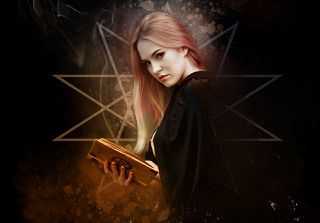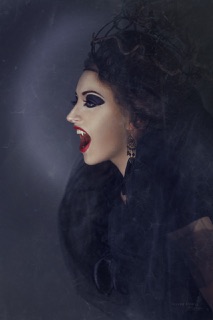It seems this time of year the topic of witches always comes up, specifically discussion around the phrase we are the witches you could not burn (or we are the granddaughters of the witches that you could not burn).
This discussion typically goes as follows:
Some people will point out that historically only so many witches were burned, and that not everyone who claims this phrase is actually said grandchild.
The point of this is typically a mockery of those who resonate with this phrase (and by extension, a shaming of the figure of the witch, even though those who engage with this will typically claim to then be practicing “true” witchcraft and those who claim this phrase are false, frauds, or the worst offense of all… New Agers).
There is then another camp that will point out that witches were both women and men. This is important historically, but it tends to leave out how women were more often harmed and killed (and in more ways than burning).
It also neglects the fact that women were punished under the guise of being a “witch” when in reality she may have been “burned” because she was elderly and no longer of use to the community, or was “possessed” or in league with the devil because she dared to have sexual urges.

Then there will be those that point out the “New Age” usage of this phase, and how witches did in fact curse and do brutal, dark things. Many of these were out of a need for survival, but there are plenty of curses that have more to do with vendettas and spite than anything else.
It is difficult for many of us to imagine the need to use magic for sheer survival, particularly of a dark variety, but matters of injustice are only rectified for certain members of our society, both past and present. In much of magic there is work to balance the scales, so to speak.
It is very true that the popularization of spiritual topics brings a glossing over of them. A de-darkening, so to speak. For example, I have seen people discuss shamanic dismemberment as if it were a pleasant thing to do on a Tuesday afternoon (and for those who do not know what this is, just look at the word “dismemberment” and question if psychically or otherwise this would be something joyous to experience).
Lately I have seen “dark night of the soul” lose its teeth and fangs, but really topics of power have been watered down and simplified and made more cuddly for a general audience for hundreds of years now.
Part of this has to do with our intellectual knowledge of magic and other areas of spiritual study far surpassing our embodied knowledge.
It is one thing to claim magic, to play the role of magician or shaman or witch, it is another to do the thing. Doing the thing requires sacrifice: time, materials gathered, energy spent, study, and most significantly, the changes in perspective and ego that occur as a result of interacting with the spirit realms.
On some deep level we know this and so there are far more people who like to discuss spiritual topics than those who choose to walk down the spiritual path, especially a moonlight path beyond the hedge into the wildness of soul.

This year there is a slightly new spin on this discussion– the insertion of atheism into the topic. The de-spiritualization of spirituality has been happening for a solid twenty years or so but has picked up a great deal of speed in the last ten.
A casual nihilism, a lack of faith in anything beyond the self (a general narcissism to many popularized spiritual movements), the movement away from organized religion (resulting in people creating their “own” spirituality), and a general disconnection as a result of societal forces is behind much of this. It is an odd thing, the sort of studying of spirituality on the one hand while claiming it is meaningless or foolish on the other.
But it happens, and the spiritual field is filled with shamans who don’t believe in spirits, magicians who only believe in scientism, and witches for whom spiritual communion and ritual is not the point nor the goal.

There is a reason that this sentiment we are the granddaughters of the witches you cannot burn is so popular.
It has little to do with the practice of witchcraft, or even much to do with the historical figure of the witch. It has everything to do with the archetypal witch.
The archetypal witch is the embodiment of the dark feminine. She is of woods and dirt, and whips herself into a frenzy in order to “power up”.
Everything that women are shamed for in our culture: sexuality, “craziness”, emotionality, power (and the ability to create) is a part of the archetypal witch.
We have shut ourselves out of the dark feminine to such a degree that any emotion is bad (I could go on a rant about spiritual ideals being strangely akin to sociopathy, but I digress), intuition is silly, and that the female body needs to twist itself into an anorexia of sheer nothingness to find any type of acceptance.
Any type of power, the pure power of creation that the dark feminine has such direct access to, is shamed, brutalized, or taken away out of fear. The primitive plain of the soul has been plundered, horns shaved down and the devil turned into a convenient bedtime story.
The body, mind, and soul are diminished so we cannot access the massive power of the dark feminine, which is equal parts brutality, clear-cutting wisdom, and fierce love.

This is the secret of the dark feminine, and understanding that rage is a gateway to power which is a key that unlocks so many doors of consciousness and capability (magical and otherwise) can let any of us understand why this phrase resonates with people.
So many of us are not ready to come face-to-face with our rage and accept it as a part of us. To do so would mean coming into contact with a type of atavistic resurgence that shakes us to the core (again… not a pleasant Tuesday afternoon).
But the stepping into the archetypal figure of the witch is an understanding that the feminine is not constructed only out of the light or the “Mother Mary” archetype– giving and sacrificing and nurturing despite herself.
It is an understanding that the dark feminine has been lost to us, and a seeking to regain something of it. That may be sharing a meme, or doing healing work, or dipping a toe into the large ocean of fury and power by knowing that it is okay if we feel angry sometimes.
The dark feminine has so often been trapped within us and aches to be free (I suggest to many of my students and clients to read The Yellow Wallpaper which illustrates the trapped feminine beautifully).
While it is certainly important to understand the literal, historical figure of the witch, the sentiments expressed by so many, the longings and rallies and cries for those burned has everything to do with connecting and communing with the dark feminine and our own embodied power.
No matter who we are or how we express ourselves we all have an archetypal witch within us, burning.
Mary Mueller Shutan is a spiritual teacher and author of several books, including the upcoming Shadow Work for the Soul
You can be notified of new blogs and random musings on social media (Facebook and Instagram)

Thanks, Ian. Glad to have you as a reader!
Excellent article, Mary, thank you. I am in the habit of ‘explaining’ and ‘expanding’ on things, sometimes too much (!), but here there is no wish…. What you write speaks for itself. Except to say – your blogs are often fascinating and valuable because they explore perspectives which are absent anywhere else that I look. And during my initial kundalini period, the words in your books saved my sanity more than once. Literally. Oh dear, I am beginning to go on now….!